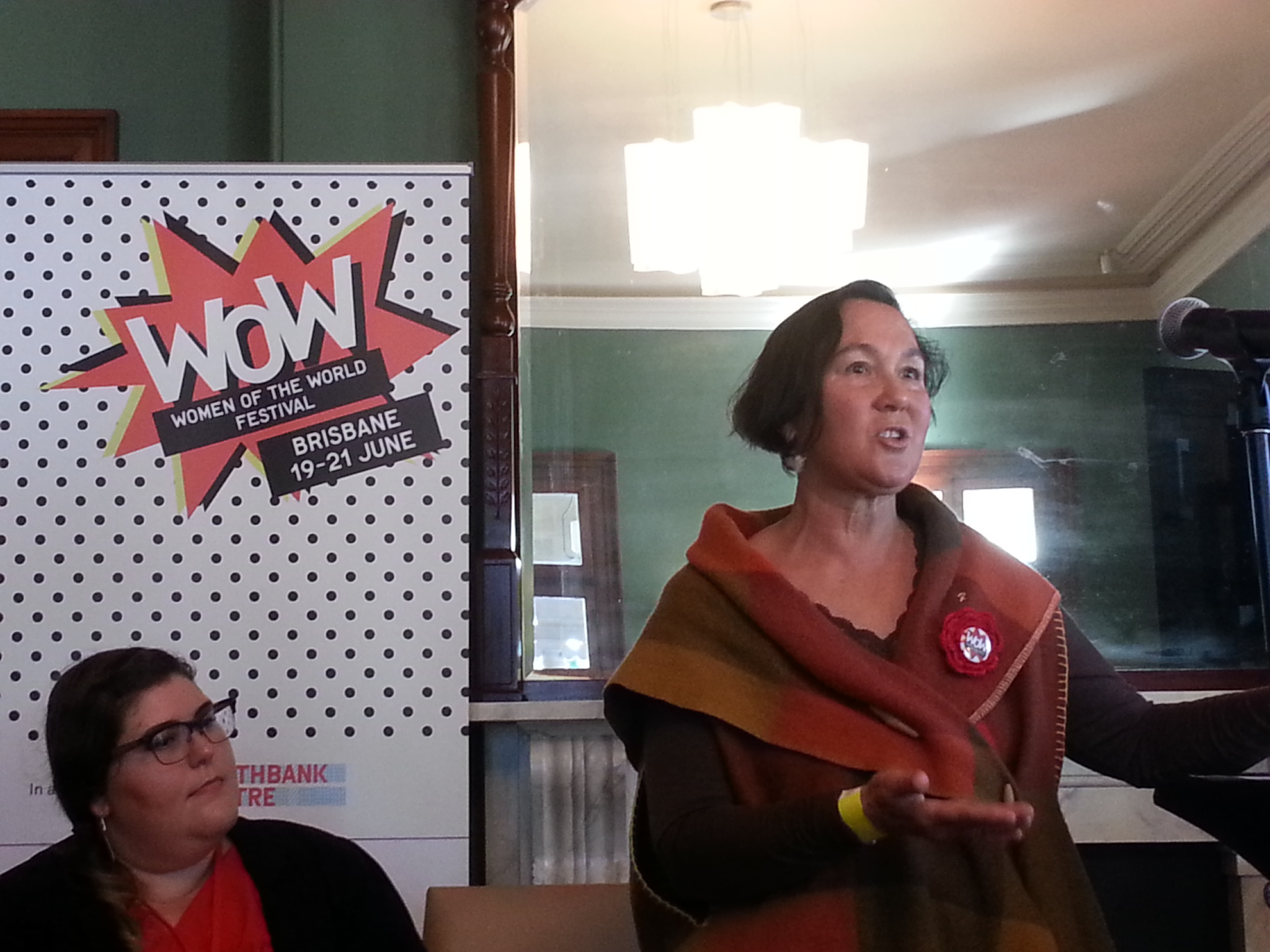Textile Beat founder Jane Milburn was invited to present a WOW Bite session at the recent Women of the World Festival in Brisbane. Below is an extract from her speech.
Today you are either wearing natural-fibre clothes – or more likely plastic clothes derived from petroleum or coal. Only 1/3 of new clothing is natural and 2/3 is synthetic, according to Food and Agriculture Organisation figures. It’s changed from half and half two decades ago. I’m wearing natural fibres that I’ve refashioned – turning a $4 wool blanket from the opshop into a poncho. This is my style of slow fashion – there are many other ways.
 Last year I ran a campaign of my own making called Sew it Again, upcycling for 365 days and writing about clothing waste and refashion. I learned a lot. I was transformed. I won a social media award. I am proud to be on the cover of the current issue of iconic sustainability magazine Grass Roots Grass Roots magazine Slow Fashion FINAL. I am doing values-based leadership. It is disruptive. I believe in slowing resource use in a society that is driven by continuous and conspicuous consumption. I want to share 10 ways you can join the slow fashion movement and embrace good clothing in the same way we now embrace good food.
Last year I ran a campaign of my own making called Sew it Again, upcycling for 365 days and writing about clothing waste and refashion. I learned a lot. I was transformed. I won a social media award. I am proud to be on the cover of the current issue of iconic sustainability magazine Grass Roots Grass Roots magazine Slow Fashion FINAL. I am doing values-based leadership. It is disruptive. I believe in slowing resource use in a society that is driven by continuous and conspicuous consumption. I want to share 10 ways you can join the slow fashion movement and embrace good clothing in the same way we now embrace good food.
- Slow down – Become conscious of what you are wearing. Clothing does for you on the outside what food does on the inside. Make considered choices, buy only from ethical makers. Shun fast fashion which is driving clothing churn. Think about why clothes are so cheap. People and places are being exploited. Remember the Rana Plaza factory collapse in 2013 when 1133 people lost their lives. That exposed the dark underbelly of fashion and sparked Fashion Revolution Day, with the call to action: Be curious, Find out, Do something.
- Develop your unique style – Find out what styles and colours work best for you. Don’t be a slave to the latest trend. Be original and create your own style. Everyone is creative, and what you wear is a great way to show your style. This can take time, and can changed depending on your age and stage, work and wallet. You might want team up with an image consultant if you don’t feel confident to do it style yourself.
- Select natural fibres – Natural fibres come from nature, they are biodegradable, and healthier next to skin. Linen is the most eco-friendly fabric, with the least embodied energy. Fibres like cotton use a lot of water – yet Australian cotton growers have reduced water use by 40% and pesticide use by 90% in the past decade. The main thing is to value the fibres, use them until they wear out. The alternative is synthetics – which research by Dr Mark Browne in 2011 revealed are shedding nearly 1900 microplastic particles with every wash, this goes into the wastewater stream, into oceans and the food chain.
- Wear clothes with a good story – What we wear affects how we feel. When we are emotionally attached to our clothes, we love wearing them again and again. I met a woman yesterday at workshop in Dysart who was wearing an Alabama Chanin skirt that it took her a year to stitch (in between caring for four young children). She looked totally gorgeous and was proud of her accomplishment – handmade with love. If you are buying new, know the labels that have ethical, traceable supply chains – you can check that through the Baptist World Aid Australian Fashion Report.
- Sewing is a life skill – learn how to, if you don’t already. Get lessons (from the Ministry of Handmade) or join the Australian Sewing Guild. Sewing is mindful and useful, just like gardening, baking, cooking and writing. Embrace imperfections and appreciate the effort.
- Re-love old gear – We can do this in many ways by sharing with friends and relatives, having swap parties, through opshops, the SWOP shop, markets and vintage stores. In the United Kingdom, nearly 1/3 of clothing goes prematurely to landfill. We don’t know what’s happening in Australia because no one is measuring it. In earlier times, clothing was never thrown away it was handed on. Older clothing is often better quality. Australia exports 70 million kgs of castoff clothing/year – to UAE, Pakistan and Malaysia (that’s 3kg per person).
- Repair what you have – A stitch in time saves nine. I love patched items because they show care. I love wearing things out. A word about washing – we do it too much and it is the biggest part of your clothing footprint. Sponge food spills, hand wash instead of dry cleaning, wash with cold water and line dry.
- Refashion – this is what I do, view clothing/textiles as resource, remake to suit yourself.
- Reduce – We have so much stuff. Buy less, of better quality. Enjoy what you have. Select a small capsule portfolio wardrobe that all works together.
- Recycle – donate, turn spent cotton items into rags, compost natural fibres.
Become conscious of your clothing footprint. Revisit your wardrobe. Be inspired to make ethical and sustainable choices in future.